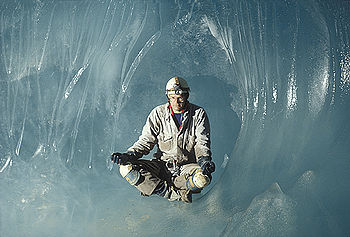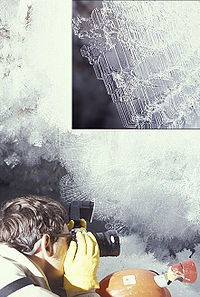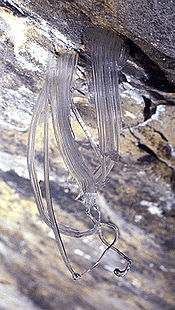
Ice cave
Encyclopedia

Cave
A cave or cavern is a natural underground space large enough for a human to enter. The term applies to natural cavities some part of which is in total darkness. The word cave also includes smaller spaces like rock shelters, sea caves, and grottos.Speleology is the science of exploration and study...
(most commonly lava tubes or limestone
Limestone
Limestone is a sedimentary rock composed largely of the minerals calcite and aragonite, which are different crystal forms of calcium carbonate . Many limestones are composed from skeletal fragments of marine organisms such as coral or foraminifera....
caves) that contains significant amounts of perennial (year-round) ice
Ice
Ice is water frozen into the solid state. Usually ice is the phase known as ice Ih, which is the most abundant of the varying solid phases on the Earth's surface. It can appear transparent or opaque bluish-white color, depending on the presence of impurities or air inclusions...
. At least a portion of the cave must have a temperature below 0 °C (32 °F) all year round, and water
Water
Water is a chemical substance with the chemical formula H2O. A water molecule contains one oxygen and two hydrogen atoms connected by covalent bonds. Water is a liquid at ambient conditions, but it often co-exists on Earth with its solid state, ice, and gaseous state . Water also exists in a...
must have traveled into the cave’s cold zone.
The term ice cave is often used to describe a cavity formed within ice, which is properly called a glacier cave
Glacier cave
A glacier cave is a cave formed within the ice of a glacier. Glacier caves are often called ice caves, but this term is properly used to describe bedrock caves that contain year-round ice.-Overview:...
.
Temperature mechanisms
BedrockBedrock
In stratigraphy, bedrock is the native consolidated rock underlying the surface of a terrestrial planet, usually the Earth. Above the bedrock is usually an area of broken and weathered unconsolidated rock in the basal subsoil...
caves are thermally insulated
Thermal insulation
Thermal insulation is the reduction of the effects of the various processes of heat transfer between objects in thermal contact or in range of radiative influence. Heat transfer is the transfer of thermal energy between objects of differing temperature...
from the surface, so commonly assume a near-constant temperature
Temperature
Temperature is a physical property of matter that quantitatively expresses the common notions of hot and cold. Objects of low temperature are cold, while various degrees of higher temperatures are referred to as warm or hot...
approximating the annual average temperature at the surface. In some cold environments, average surface (and thus cave) temperatures are below freezing, and with surface water available in summer, ice caves are possible. However, many ice caves exist in temperate
Temperate
In geography, temperate or tepid latitudes of the globe lie between the tropics and the polar circles. The changes in these regions between summer and winter are generally relatively moderate, rather than extreme hot or cold...
climates, due to mechanisms that result in cave temperatures being colder than average surface temperatures where they formed.

Convection
Convection is the movement of molecules within fluids and rheids. It cannot take place in solids, since neither bulk current flows nor significant diffusion can take place in solids....
to import cold air from the surface in winter, but not warm air in summer. A typical example is an underground chamber located below a single entrance. In winter, cold dense air settles into the cave, displacing any warmer air which rises and exits the cave. In summer, the cold cave air remains in place as the relatively warm surface air is lighter and cannot enter. The cave will only exchange air when the surface air is cooler than the cave air. Some cold traps may ensnare surface snow
Snow
Snow is a form of precipitation within the Earth's atmosphere in the form of crystalline water ice, consisting of a multitude of snowflakes that fall from clouds. Since snow is composed of small ice particles, it is a granular material. It has an open and therefore soft structure, unless packed by...
and shade it from the summer sun
Sun
The Sun is the star at the center of the Solar System. It is almost perfectly spherical and consists of hot plasma interwoven with magnetic fields...
’s rays
Sunlight
Sunlight, in the broad sense, is the total frequency spectrum of electromagnetic radiation given off by the Sun. On Earth, sunlight is filtered through the Earth's atmosphere, and solar radiation is obvious as daylight when the Sun is above the horizon.When the direct solar radiation is not blocked...
, which may further contribute to the colder cave temperature.
Permafrost - Even temperate environments can include pockets of bedrock that are below freezing year round, a condition called permafrost
Permafrost
In geology, permafrost, cryotic soil or permafrost soil is soil at or below the freezing point of water for two or more years. Ice is not always present, as may be in the case of nonporous bedrock, but it frequently occurs and it may be in amounts exceeding the potential hydraulic saturation of...
. For example, winter wind and an absence of snow cover may allow freezing deep enough to be protected from summer thaw, particularly in light-colored rock
Rock (geology)
In geology, rock or stone is a naturally occurring solid aggregate of minerals and/or mineraloids.The Earth's outer solid layer, the lithosphere, is made of rock. In general rocks are of three types, namely, igneous, sedimentary, and metamorphic...
that does not readily absorb heat. Although the portion of a cave within this permafrost zone will be below freezing, permafrost generally does not allow water percolation
Percolation
In physics, chemistry and materials science, percolation concerns the movement and filtering of fluids through porous materials...
, so ice formations are often limited to crystals from vapor
Vapor
A vapor or vapour is a substance in the gas phase at a temperature lower than its critical point....
, and deeper cave passages may be arid and completely ice-free. Ice caves in permafrost need not be cold-traps (although some are), provided they do not draught significantly in summer.
Evaporative cooling - In winter, dry surface air entering a moisture-saturated cave may have an additional cooling effect due to the latent heat
Latent heat
Latent heat is the heat released or absorbed by a chemical substance or a thermodynamic system during a process that occurs without a change in temperature. A typical example is a change of state of matter, meaning a phase transition such as the melting of ice or the boiling of water. The term was...
of evaporation
Evaporation
Evaporation is a type of vaporization of a liquid that occurs only on the surface of a liquid. The other type of vaporization is boiling, which, instead, occurs on the entire mass of the liquid....
. This may create a zone within the cave that is cooler than the rest of the cave. Because many caves have seasonally-reversing draughts, the corresponding warming of the cave through condensation
Condensation
Condensation is the change of the physical state of matter from gaseous phase into liquid phase, and is the reverse of vaporization. When the transition happens from the gaseous phase into the solid phase directly, the change is called deposition....
in summer may occur at a different location within the cave, but in any event a moisture-saturated cave environment is likely to experience much more evaporative cooling than condensative warming.
Types of ice in ice caves

Ponded water - Surface water that collects and ponds in a cave before freezing will form a clear ice mass, and can be tens of metres thick and of great age. Large ice masses are plastic
Plasticity (physics)
In physics and materials science, plasticity describes the deformation of a material undergoing non-reversible changes of shape in response to applied forces. For example, a solid piece of metal being bent or pounded into a new shape displays plasticity as permanent changes occur within the...
and can slowly flow in response to gravity or pressure from further accumulations. Sculpting from air flow and sublimation may reveal ancient accumulation bands within the ice.
Accumulated snow - Compressed under the weight of ongoing accumulations, snow sliding or falling into a cave entrance may eventually form ice that is coarsely crystalline, akin to glacier
Glacier
A glacier is a large persistent body of ice that forms where the accumulation of snow exceeds its ablation over many years, often centuries. At least 0.1 km² in area and 50 m thick, but often much larger, a glacier slowly deforms and flows due to stresses induced by its weight...
ice. True underground glaciers are rare.
Ice formations - Water that freezes before ponding may form icicle
Icicle
An icicle is a spike of ice formed when water dripping or falling from an object freezes. Typically, icicles will form when ice or snow is melted by either sunlight or some other heat source , and the resulting melted water runs off into an area where the ambient temperature is below the freezing...
s, ice-stalagmite
Stalagmite
A stalagmite is a type of speleothem that rises from the floor of a limestone cave due to the dripping of mineralized solutions and the deposition of calcium carbonate. This stalagmite formation occurs only under certain pH conditions within the underground cavern. The corresponding formation on...
s, ice columns or frozen waterfall
Waterfall
A waterfall is a place where flowing water rapidly drops in elevation as it flows over a steep region or a cliff.-Formation:Waterfalls are commonly formed when a river is young. At these times the channel is often narrow and deep. When the river courses over resistant bedrock, erosion happens...
s.
Airborne moisture (water vapor) – Freezing vapor can form frost
Frost
Frost is the solid deposition of water vapor from saturated air. It is formed when solid surfaces are cooled to below the dew point of the adjacent air as well as below the freezing point of water. Frost crystals' size differ depending on time and water vapour available. Frost is also usually...
crystals, frost feathers and two-dimensional ice plates on the cave walls and ceiling.
Needle ice
Needle ice
Needle ice is a phenomenon that occurs when the temperature of the soil is above and the surface temperature of the air is below . The subterranean liquid water is brought to the surface via capillary action, where it freezes and contributes to a growing needle-like ice column.The ice needles are...
- Infiltrating water that freezes within the bedrock can sometimes be forced into the cave passage.
Intrusions - The weight of a surface glacier perched atop a cave entrance can force glacial ice a short distance into the cave. The only known examples of this phenomenon are the several 'ice plugs' at the back of Castleguard Cave
Castleguard Cave
Castleguard Cave is a limestone cave located at the north end of Banff National Park in the Rocky Mountains of Canada. With 20,357m of surveyed passages , it is Canada's longest cave, and its fifth deepest at 384m...
in Alberta
Alberta
Alberta is a province of Canada. It had an estimated population of 3.7 million in 2010 making it the most populous of Canada's three prairie provinces...
.
External links
- Kungur Ice Cave Russia - Road maps,routes,useful info's, pictures gallery
- Video of an ice cave in the Big Snowy Mountains of Montana
- Big Ice Cave in the Pryor Mountains of Montana
- Speleoglacio Ice Cave Research Group
- An ice cave in Italy
- Eisriesenwelt Ice Cave photos (click on "Gallery")
- Kungur Ice Cave

